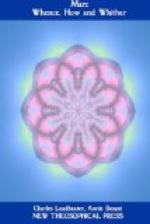[Footnote A: Weismann, Essays, p. 88.]
Here again natural selection of individuals, not the diminished supply of nutriment, has to determine which of many muscles shall be poorly fed and which favored. But natural selection can favor special organs only indirectly through the individuals which possess such organs. Variation is fortuitous, and there is nothing, except natural selection, to combine or direct them. And, I think, we have already seen that any theory which neglects or excludes such directing and combining agencies must be unsatisfactory and inadequate. Weismann has promised us an explanation of correlation of variation in accordance with his theory; and if such an explanation can be made, it would remove one of the strongest objections. But for the present the objection has very great weight.
Furthermore, as Osborne has insisted, linear variations, or variations proceeding along certain single and well-marked lines, would seem inexplicable by, if not fatal to, Weismann’s theory. And yet Osborne, Cope, and others have shown that the teeth of mammals have developed steadily along well-marked lines. They have apparently not resulted at all by selection from a host of fortuitous variations.
Says Osborne in his “Cartwright Lectures"[A]: “It is evident that use and disuse characterize all the centres of evolution; that changes of structure are slowly following on changes of function or habit. In eight independent regions of evolution in the human body there are upward of twenty developing organs, upward of thirty degenerating organs.” Now this parallelism, through a long series of generations, between the evolution of organs, their advance or degeneration, and the use or disuse of these same organs, that is, of the habits of the individual, is certainly of great significance. It must have an explanation; and the most natural one would seem to be the transmission of the effects of use and disuse.
[Footnote A: American Naturalist, vols. xxv. and xxvi.]




